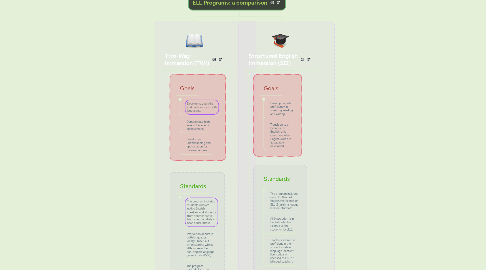
1. Two-Way Immersion (TWI)
1.1. Goals
1.1.1. Develop strong skills and proficiency in both languages.
1.1.2. Demonstrate high levels of academic achievement.
1.1.3. Develop an understanding and appreciation for diverse cultures.
1.2. Standards
1.2.1. The program includes students who are native English speakers and students from another native language (hopefully in near-equal ratios).
1.2.2. Instruction occurs in both languages, ideally 50/50, but often starting with a little more in the non-English language (as much as 90/10).
1.2.3. The program typically lasts the duration of elementary school.
1.3. Strategies
1.3.1. Create language rich environments.
1.3.2. Employ collaborative activities where students can assist each other.
1.3.3. Use hands-on activities.
1.3.4. Produce visual and graphic material in abundance.
1.3.5. Repeat and rephrase to ensure concepts are digested.
1.3.6. Craft thematic units.
2. Structured English Immersion (SEI)
2.1. Goals
2.1.1. Develop English proficiency in speaking, reading, and writing.
2.1.2. Transition to a bi-lingual or English-only classroom when English skills are adequately developed.
2.2. Standards
2.2.1. The program includes only LEP (limited English Proficient), or ELL (English language learner) students.
2.2.2. All instruction is in English, which is tailored to the students' level(s).
2.2.3. Teachers should be proficient in the students' native language, content licensed, and licensed as ESL or bilingual teachers.
2.2.4. Students receive feedback in English.
2.3. Strategies
2.3.1. Produce comprehensible material.
2.3.2. Create opportunities for language output.
2.3.3. Use pre-reading techniques to help reading comprehension.
2.3.4. Develop a system for positive feedback.
